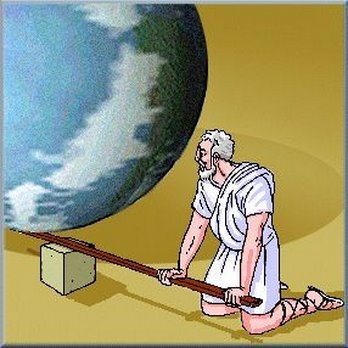TA
MEGEQEA ISORROPEONTI APO MAKEWN ANTIPEPONQOTWS TON AUTON LOGON ECONTWN TOIS
BARESIN.
Magnitudes are in equilibrium at distances reciprocally proportional to their weights.
(picture from http://www.buzzle.com/editorials/7-30-2004-57259.asp)
How do small forces move large objects
through the use of the lever?
Archimedes did not invent the lever or the pulley, it had been in use from early human times. He simply explained the geometry behind it; in short, why it so effective.
Which of the two examples above would you rather
push in order to raise the block?
The top one, right. It is a simple instinct to us to choose
the correct answer, because this concept has affected our choices from a young
age; it is an unconscious decision. We don’t approach a door and push on it near
the hinge and expect it to swing open easily. But why is this?
Because the lever works by trading effort for
distance. The fulcrum, located between the weight and force acting on it, acts
as the pivot point. Recall Physics
101…
Work = (Force)(distance)
At a greater distance, the amount of work is decreased to produce the same amount of work. If you wanted to make your effort one quarter of the original force, you need to increase the distance of the pushing point of the fulcrum by 75%.
Archimedes is also credited with the invention of the compound pulley.
The force pulling down on the pulley, in this case the black anvil weighing 1, is equal and opposite in direction to the tension of the ropes. In order to describe the simple pulley’s effectiveness we will ignore the friction of the rope and pulley. The force needed to life is divided in two because the ceiling, or point of attachment of rope, carries half of it. The second pulley directing the rope downward has no further advantage, but simple serves to redirect the force.
Archimedes is said to have used many compound pulleys to lift the Syracusia out of its dry dock.


